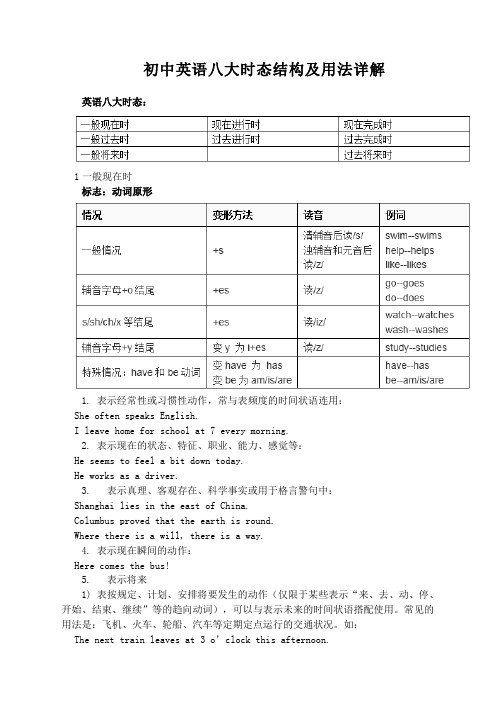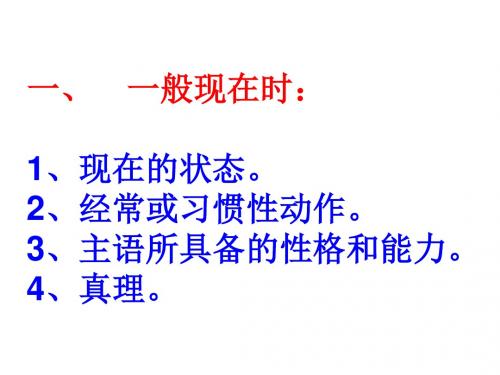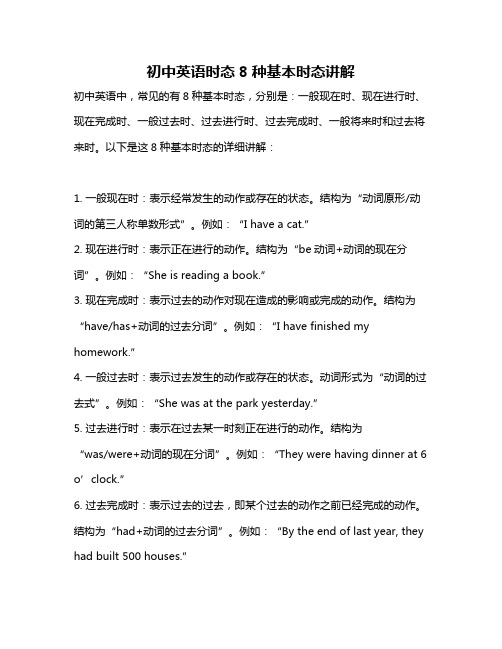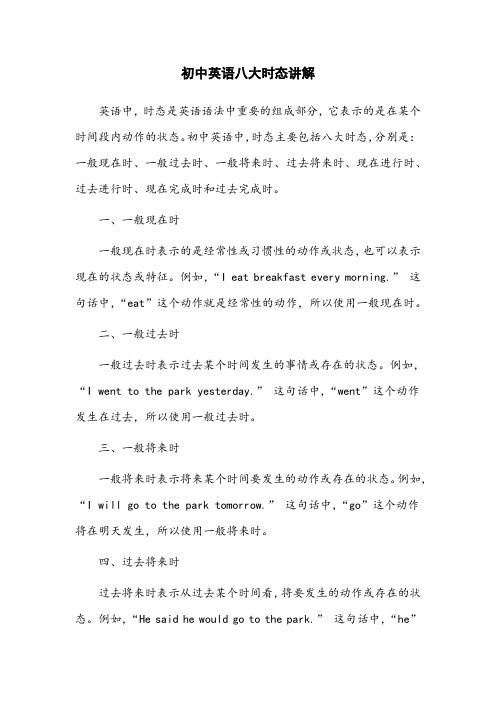初中英语时态标志词+例句讲解学习
初中英语八大时态结构及用法详解

初中英语八大时态结构及用法详解英语八大时态:1一般现在时标志:动词原形1. 表示经常性或习惯性动作,常与表频度的时间状语连用:She often speaks English.I leave home for school at 7 every morning.2. 表示现在的状态、特征、职业、能力、感觉等:He seems to feel a bit down today.He works as a driver.3. 表示真理、客观存在、科学事实或用于格言警句中:Shanghai lies in the east of China.Columbus proved that the earth is round.Where there is a will, there is a way.4. 表示现在瞬间的动作:Here comes the bus!5. 表示将来1) 表按规定、计划、安排将要发生的动作(仅限于某些表示“来、去、动、停、开始、结束、继续”等的趋向动词),可以与表示未来的时间状语搭配使用。
常见的用法是:飞机、火车、轮船、汽车等定期定点运行的交通状况。
如:The next train leaves at 3 o’clock this afternoon.How often does the shuttle bus run?2) 在时间和条件状语从句中常使用一般现在时表示将来发生的事情:When Bill comes (不用will come), ask him to wait for me.I shall go there tomorrow unless I’m too busy.2一般过去时标志:动词过去式*闭音节:元音字母a, e, i, o, u如果发字母本来的音则称为开音节,否则称为闭音节。
1. 表示过去某时所发生的动作或存在的状态,常与表示过去的时间状语连用(e.g. yesterday, this morning, just now, a moment ago, in May, last night / year / week, once upon a time, the other day, before …, when …, in the past等)。
初一英语常见的时态讲解及例句

练习: 1. Jim ______(take) photos in the park now. 2. Jim_______(not take) in the park now.
3. _____Jim_____(take) photos in the park now? Yes, he _____. No, he _______. 4. Where _________Jim ____________ photos now? In the park.
10.They _____(be) frห้องสมุดไป่ตู้m Canada They______(not speak) Chinese.
11. He wants _____ (be) tall.
1.我们正在吃晚餐。 We ___________________
2、我们每天6点起床。 We _________ at six every day.
4. You and I ___(not be) in Class Six. 5.___(be) there a supermarket on the Fifth Avenue? Yes, there_____ (be). 6. ____ her parent tall? No, he____.
1)His parents _______(watch) TV every night. 肯定句 2) My brother _________(do) homework every day. 3)His parents _______(not watch) every night.否定句 4)My brother________(not do)homework every day.
时态复习的思维步骤应是: 一时间、 二主语、 三动词。
初中英语时态8种基本时态讲解

初中英语时态8种基本时态讲解初中英语中,常见的有8种基本时态,分别是:一般现在时、现在进行时、现在完成时、一般过去时、过去进行时、过去完成时、一般将来时和过去将来时。
以下是这8种基本时态的详细讲解:1. 一般现在时:表示经常发生的动作或存在的状态。
结构为“动词原形/动词的第三人称单数形式”。
例如:“I have a cat.”2. 现在进行时:表示正在进行的动作。
结构为“be动词+动词的现在分词”。
例如:“She is reading a book.”3. 现在完成时:表示过去的动作对现在造成的影响或完成的动作。
结构为“have/has+动词的过去分词”。
例如:“I have finished my homework.”4. 一般过去时:表示过去发生的动作或存在的状态。
动词形式为“动词的过去式”。
例如:“She was at the park yesterday.”5. 过去进行时:表示在过去某一时刻正在进行的动作。
结构为“was/were+动词的现在分词”。
例如:“They were having dinner at 6 o’clock.”6. 过去完成时:表示过去的过去,即某个过去的动作之前已经完成的动作。
结构为“had+动词的过去分词”。
例如:“By the end of last year, they had built 500 houses.”7. 一般将来时:表示将来要发生的动作或存在的状态。
结构为“will+动词原形”或“am/is/are going to+动词原形”。
例如:“We will visit the museum next week.”8. 过去将来时:表示从过去的某一时刻看,将来要发生的动作或存在的状态。
结构为“would+动词原形”或“was/were going to+动词原形”。
例如:“He said he would come back soon.”以上就是初中英语8种基本时态的讲解,希望对你有帮助!。
初中英语的时态知识点总结

初中英语的时态知识点总结一、一般现在时一般现在时表示经常发生的动作或现在存在的状态。
它在句子中通常与通常时间状语连用,如often, usually, sometimes等。
动词在一般现在时中分为be动词和实义动词两种情况。
1. Be动词的变化- 主语为第一人称单数(I)时,用am。
- 主语为第二人称单数(you)、第三人称单数(he, she, it)或名词单数时,用is。
- 主语为第一人称复数(we)、第二人称复数(you)、第三人称复数(they)或名词复数时,用are。
例句:- I am a student.- She is a teacher.- They are friends.2. 实义动词的变化- 当主语为第三人称单数时,动词通常要加-s或-es后缀。
- 一般情况下,动词后加-s。
- 以s, x, sh, ch, o(加es的词)等结尾的动词加-es。
例句:- He plays football every day.- The buses leave at 8 a.m.二、一般过去时一般过去时表示过去某一确定时间发生的动作或存在的状态。
动词在一般过去时中要变为过去式,一般在词尾加-ed。
1. 规则变化- 动词词尾加-ed(如:played, visited)。
- 以e结尾的动词加-d(如:lived, danced)。
- 以辅音字母+y结尾的动词,变y为i再加-ed(如:studied, copied)。
2. 不规则变化不规则动词的过去式变化没有固定规则,需要特别记忆。
例如:- go去了went。
- eat吃了ate。
- begin开始began。
三、一般将来时一般将来时表示将来某一时间会发生的动作或状态。
它的构成主要有以下几种方式。
1. 将will或shall加在动词原形之前。
- I will go to school tomorrow.- He shall finish the work.2. 用“be going to + 动词原形”表示计划或打算做的事情。
初中英语八大时态详解

初中英语八大时态详解一般现在时标志:动词原形1. 表示经常性或习惯性动作:She often speaks English.I leave home for school at 7 every morning.2. 表示现在的状态、特征、职业、能力、感觉等:He seems to feel a bit down today.He works as a driver.3. 表示真理、客观存在、科学事实或用于格言警句中:Shanghai lies in the east of China.Columbus proved that the earth is round.Where there is a will, there is a way.注意:在时间和条件状语从句中常使用一般现在时表将来When Bill comes , ask him to wait for me.I shall go there tomorrow unless I’m too busy.02一般过去时标志:动词过去式1. 表示过去某时所发生的动作或存在的状态,如:Jim rang you just now.Liu Ying was in America last year.2. 表示过去经常或反复发生的动作,特别是used to do表达的句型,本身表示的就是过去常常。
如:When I was a kid, I often played football in the street.She used to visit her mother once a week.*注意区分sb. used to do sth.(某人过去常常做某事,此处to是动词不定式标志符号)和sb. be used to sth./doing sth.(某人习惯于某物/做某事,此处to是介词)。
3. 代替一般现在时,表示一种婉转、客气、礼貌、商量的语气。
英语各个时态的句子结构及标志词

英语各个时态的句子结构及标志词一般现在时:句子结构:主语+谓语动词(原形)+其他成分例句:I always go to the gym after work.我每天下班后都去健身房。
一般过去时:句子结构:主语+谓语动词的过去式+其他成分标志词:yesterday, last night/week/month/year, in 2024, etc.例句:She lived in London for five years.她在伦敦住了五年。
一般将来时:句子结构:主语 + will + 谓语动词(原形)+ 其他成分标志词:tomorrow, next week/month/year, in the future, etc.例句:We will visit my grandparents this weekend.我们这个周末将去看望我的祖父母。
现在进行时:句子结构:主语 + am/is/are + 现在分词 + 其他成分标志词:now, at the moment, at present, currently, etc.例句:They are studying for their exams right now.他们正在为考试而学习。
过去进行时:句子结构:主语 + was/were + 现在分词 + 其他成分例句:I was cooking dinner when she called me.将来进行时:句子结构:主语 + will be + 现在分词 + 其他成分明年这个时候他将在国外留学。
一般过去完成时:句子结构:主语 + had + 过去分词 + 其他成分例句:She had already finished her work when her boss arrived.她的老板来的时候,她已经完成了工作。
一般将来完成时:句子结构:主语 + will have + 过去分词 + 其他成分在你回来的时候,我们已经大学毕业了。
初一常用动词时态总结及例句分析

初一常用动词时态总结及例句分析动词时态是英语语法中的一个重要概念,它表示动作或状态发生的时间。
在初一阶段,学生们需要学习常用的动词时态,并掌握其正确的使用方法。
本文将对初一常用动词时态进行总结,并提供相应的例句进行分析。
一、一般现在时(Simple Present Tense)一般现在时表示经常性的动作、事实、习惯或普遍真理。
1. 动词规则变化:主语 + 动词原形(第三人称单数加s)例句:- I always go to school by bus.(我总是乘公共汽车去学校。
)- She eats breakfast every morning.(她每天早上吃早餐。
)- Dogs bark.(狗会叫。
)2. 特殊用法:- 表示现在的状态:I am a student.(我是个学生。
)- 表示经常性的真理:The sun rises in the east.(太阳从东方升起。
)二、一般过去时(Simple Past Tense)一般过去时表示过去某个时间发生的动作或状态。
1. 动词规则变化:主语 + 动词过去式例句:- I watched a movie last night.(昨晚我看了一部电影。
)- He played football with his friends yesterday.(昨天他和他的朋友们踢足球。
)- They visited their grandparents last summer.(他们去年夏天拜访了他们的祖父母。
)2. 特殊用法:- 表示过去的习惯:He always ate breakfast at 7 o'clock when he was young.(他年轻时总是在7点吃早饭。
)- 表示过去的真理:Newton discovered the law of gravity.(牛顿发现了万有引力定律。
)三、一般将来时(Simple Future Tense)一般将来时表示将来某个时间会发生的动作或状态。
初中英语八大时态讲解

初中英语八大时态讲解英语中,时态是英语语法中重要的组成部分,它表示的是在某个时间段内动作的状态。
初中英语中,时态主要包括八大时态,分别是:一般现在时、一般过去时、一般将来时、过去将来时、现在进行时、过去进行时、现在完成时和过去完成时。
一、一般现在时一般现在时表示的是经常性或习惯性的动作或状态,也可以表示现在的状态或特征。
例如,“I eat breakfast every morning.”这句话中,“eat”这个动作就是经常性的动作,所以使用一般现在时。
二、一般过去时一般过去时表示过去某个时间发生的事情或存在的状态。
例如,“I went to the park yesterday.”这句话中,“went”这个动作发生在过去,所以使用一般过去时。
三、一般将来时一般将来时表示将来某个时间要发生的动作或存在的状态。
例如,“I will go to the park tomorrow.”这句话中,“go”这个动作将在明天发生,所以使用一般将来时。
四、过去将来时过去将来时表示从过去某个时间看,将要发生的动作或存在的状态。
例如,“He said he would go to the park.”这句话中,“he”认为“he would go to the park”是未来要发生的事情,所以使用过去将来时。
五、现在进行时现在进行时表示正在进行的动作或存在的状态。
例如,“I am eating an apple.”这句话中,“eating”这个动作正在进行,所以使用现在进行时。
六、过去进行时过去进行时表示过去某个时间正在进行的动作或存在的状态。
例如,“She said she was watching TV at 8 o’clock last night.”这句话中,“watching TV”这个动作在昨晚8点正在进行,所以使用过去进行时。
七、现在完成时现在完成时表示过去发生的动作对现在造成的影响或结果,也可以表示持续到现在的动作或状态。
- 1、下载文档前请自行甄别文档内容的完整性,平台不提供额外的编辑、内容补充、找答案等附加服务。
- 2、"仅部分预览"的文档,不可在线预览部分如存在完整性等问题,可反馈申请退款(可完整预览的文档不适用该条件!)。
- 3、如文档侵犯您的权益,请联系客服反馈,我们会尽快为您处理(人工客服工作时间:9:00-18:30)。
初中英语时态标志词+
例句
初中英语时态标志词
一、一般现在时:
1.概念:经常、反复发生的动作或行为及现在的某种状况。
2.时间状语: always, usually, often, sometimes, every week (day, year, month…), once a week, on Sundays。
3.基本结构:动词原形(如主语为第三人称单数,动词上要加(e)S)。
4.否定形式:am/is/are+not;此时态的谓语动词若为行为动词,则在其前加don't,如主语为第三人称单数,则用doesn't,同时还原行为动词。
5.一般疑问句:把be动词放于句首;用助动词do提问,如主语为第三人称单数,则用does,同时,还原行为动词。
6.例句:. It seldom snows here.
He is always ready to help others.
Action speaks louder than words.
二、一般过去时:
1.概念:过去某个时间里发生的动作或状态;过去习惯性、经常性的动作、行为。
2.时间状语:ago, yesterday, the day before yesterday, last week(year, night, month…), in 1989, just now, at the age of 5, one day, long long ago, once upon a time, etc.
3.基本结构:be动词;行为动词
4.否定形式:was/were+not;在行为动词前加didn't,同时还原行为动词。
5.一般疑问句:was或were放于句首;用助动词do的过去式did 提问,同时还原行为动词。
6.例句:She often came to help us in those days.
I didn't know you were so busy.
三、现在进行时:
1.概念:表示现阶段或说话时正在进行的动作及行为。
2.时间状语:now, at this time, these days, etc.
3.基本结构:am/is/are+doing
4.否定形式:am/is/are+not+doing.
5.一般疑问句:把be动词放于句首。
6.例句: How are you feeling today?
He is doing well in his lessons.
四、过去进行时:
1.概念:表示过去某段时间或某一时刻正在发生或进行的行为或动作。
2.时间状语:at this time yesterday, at that time或以when引导的谓语动词是一般过去时的时间状语等。
3.基本结构:was/were+doing
4.否定形式:was/were + not + doing.
5.一般疑问句:把was或were放于句首。
6.例句:At that time she was working in a PLA unit.
When he came in, I was reading a newspaper.
五、现在完成时:
1.概念:过去发生或已经完成的动作对现在造成的影响或结果,或从过去已经开始,持续到现在的动作或状态。
2.时间状语:recently, lately, since…for…,in the past few years, etc.
作者:218.59.157.*2009-3-23 11:19 回复此发言
--------------------------------------------------------------------------------
2 英语中的八种基本时态
3.基本结构:have/has + done
4.否定形式:have/has + not +d one.
5.一般疑问句:have或has。
6.例句:I've written an article.
It has been raining these days.
六、过去完成时:
1.概念:以过去某个时间为标准,在此以前发生的动作或行为,或在过去某动作之前完成的行为,即“过去的过去”。
2.时间状语:before, by the end of last year(term, month…),etc.
3.基本结构:had + done.
4.否定形式:had + not + done.
5.一般疑问句:had放于句首。
6.例句:As soon as we got to the station, the train had left.
By the end of last month, We had reviewed four books
七、一般将来时:
1.概念:表示将要发生的动作或存在的状态及打算、计划或准备做某事。
2.时间状语:tomorrow, next day(week, month, year…),soon, in a few minutes, by…,the day after tomorrow, etc.
3.基本结构:am/is/are/going to + do;will/shall + do.
4.否定形式:was/were + not; 在行为动词前加didn't,同时还原行为动词。
5.一般疑问句:be放于句首;will/shall提到句首。
6.例句:They are going to have a competition with us in studies.
It is going to rain.
八、过去将来时:
1.概念:立足于过去某一时刻,从过去看将来,常用于宾语从句中。
2.时间状语:the next day(morning, year…),the following month(week…),etc.
3.基本结构:was/were/going to + do;would/should + do.
4.否定形式:was/were/not + going to + do; would/should + not + do.
5.一般疑问句:was或were放于句首;would/should 提到句首。
6.例句:He said he would go to Beijing the next day.
I asked who was going there。
